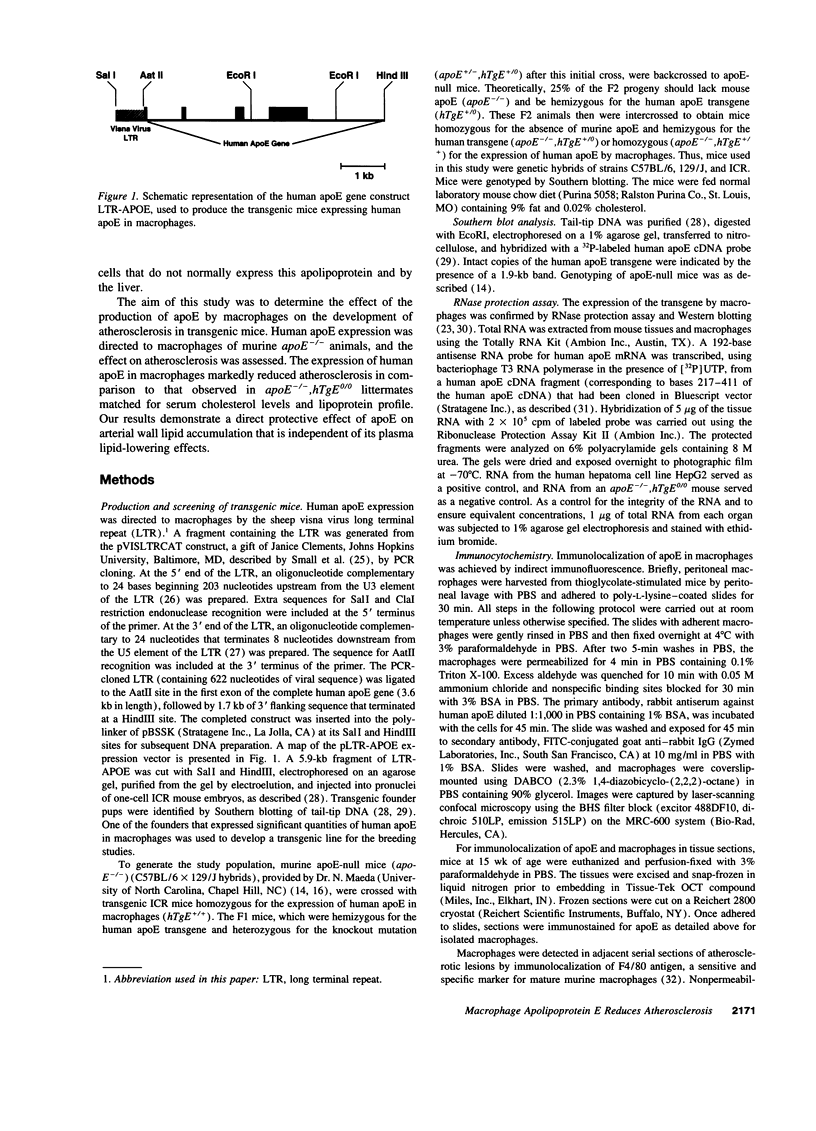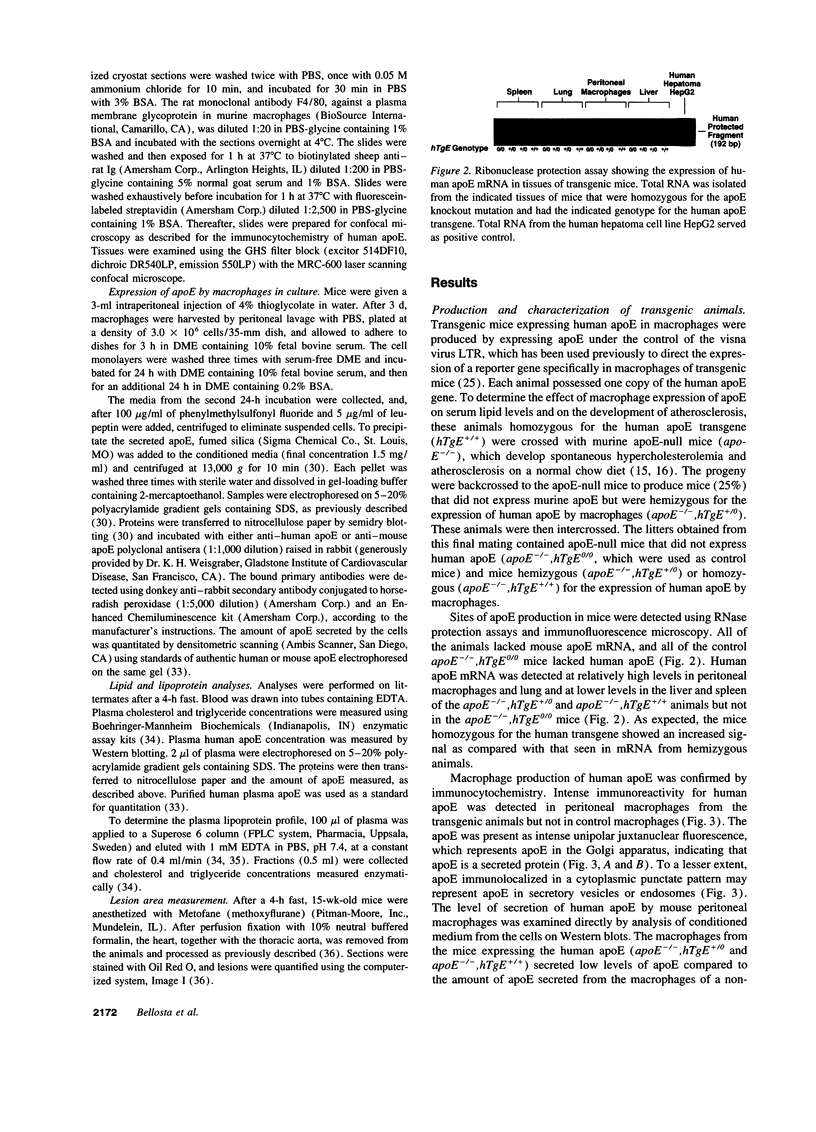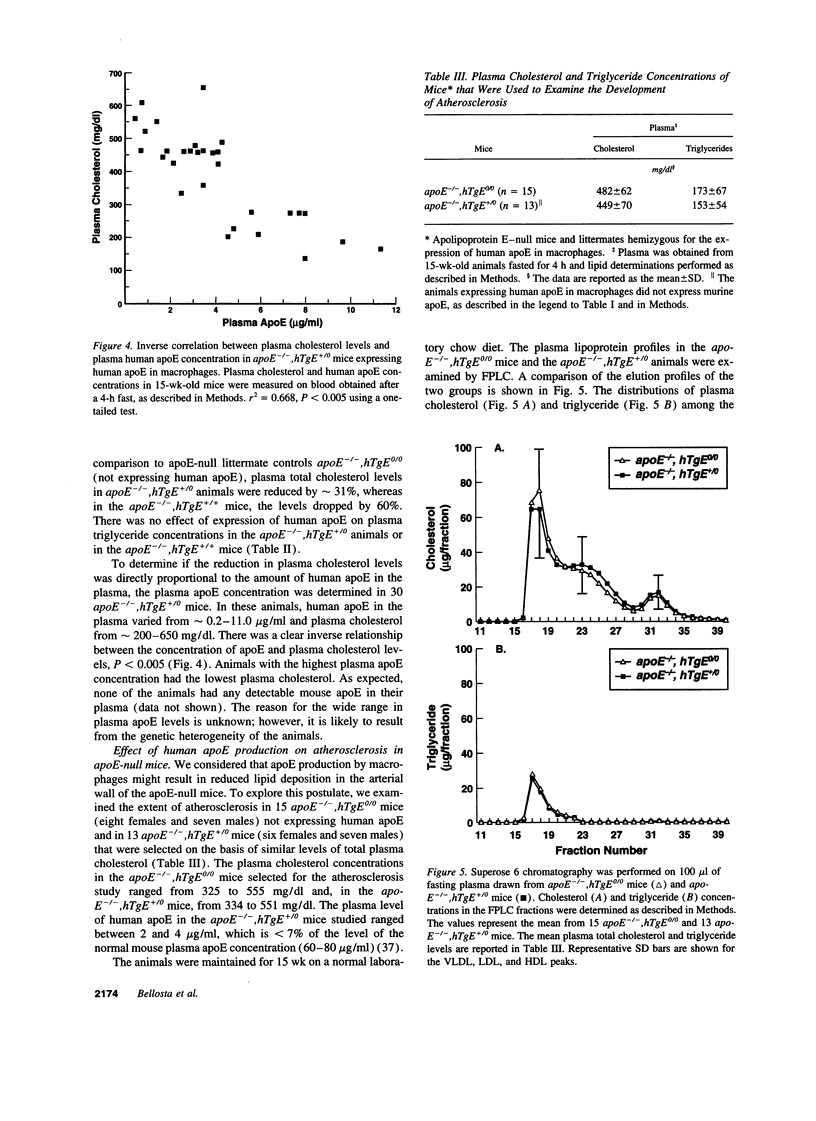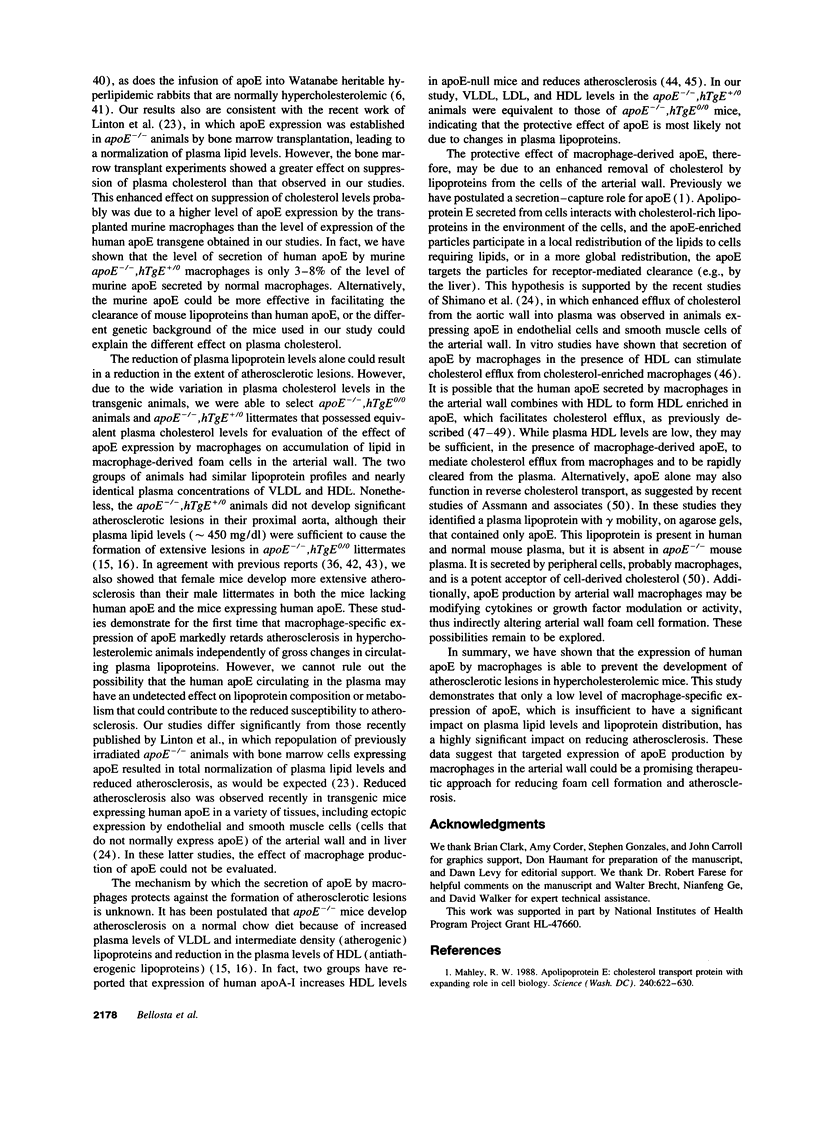Abstract
apoE deficiency causes hyperlipidemia and premature atherosclerosis. To determine if macrophage-specific expression of apoE would decrease the extent of atherosclerosis, we expressed human apoE in macrophages of apoE-null mice (apoE-/-) and assessed the effect on lipid accumulation in cells of the arterial wall. Macrophage-specific expression of human apoE in normal mice was obtained by use of the visna virus LTR. These animals were bred with apoE-/- mice to produce animals hemizygous for expression of human apoE in macrophages in the absence of murine apoE (apoE-/-,hTgE+/0). Low levels of human apoE mRNA were present in liver and spleen and high levels in lung and peritoneal macrophages. Human apoE was secreted by peritoneal macrophages and was detected in Kupffer cells of the liver. Human apoE in the plasma of apoE-/-,hTgE+/0 mice (n = 30) was inversely correlated (P < 0.005) with the plasma cholesterol concentration. After 15 wk on a normal chow diet, atherosclerosis was assessed in apoE-/-,hTgE+/0 animals and in apoE-/-,hTgE0/0 littermates matched for plasma cholesterol level (approximately 450 mg/dl) and lipoprotein profile. There was significantly less atherosclerosis in both the aortic sinus and in the proximal aorta (P < 0.0001) in the animals expressing the human apoE transgene. In apo-E-/-,hTgE+/0 animals, which had detectable atherosclerotic lesions, human apoE was detected in the secretory apparatus of macrophage-derived foam cells in the arterial wall. The data demonstrate that expression of apoE by macrophages is antiatherogenic even in the presence of high levels of atherogenic lipoproteins. The data suggest that apoE prevents atherosclerosis by promoting cholesterol efflux from cells of the arterial wall.
Full text
PDF









Images in this article
Selected References
These references are in PubMed. This may not be the complete list of references from this article.
- Davies M. J., Woolf N., Rowles P. M., Pepper J. Morphology of the endothelium over atherosclerotic plaques in human coronary arteries. Br Heart J. 1988 Dec;60(6):459–464. doi: 10.1136/hrt.60.6.459. [DOI] [PMC free article] [PubMed] [Google Scholar]
- Driscoll D. M., Getz G. S. Extrahepatic synthesis of apolipoprotein E. J Lipid Res. 1984 Dec 1;25(12):1368–1379. [PubMed] [Google Scholar]
- Eisenberg S., Friedman G., Vogel T. Enhanced metabolism of normolipidemic human plasma very low density lipoprotein in cultured cells by exogenous apolipoprotein E-3. Arteriosclerosis. 1988 Sep-Oct;8(5):480–487. doi: 10.1161/01.atv.8.5.480. [DOI] [PubMed] [Google Scholar]
- Faggiotto A., Ross R., Harker L. Studies of hypercholesterolemia in the nonhuman primate. I. Changes that lead to fatty streak formation. Arteriosclerosis. 1984 Jul-Aug;4(4):323–340. doi: 10.1161/01.atv.4.4.323. [DOI] [PubMed] [Google Scholar]
- Fazio S., Yao Z., McCarthy B. J., Rall S. C., Jr Synthesis and secretion of apolipoprotein E occur independently of synthesis and secretion of apolipoprotein B-containing lipoproteins in HepG2 cells. J Biol Chem. 1992 Apr 5;267(10):6941–6945. [PubMed] [Google Scholar]
- Gabuzda D. H., Hess J. L., Small J. A., Clements J. E. Regulation of the visna virus long terminal repeat in macrophages involves cellular factors that bind sequences containing AP-1 sites. Mol Cell Biol. 1989 Jun;9(6):2728–2733. doi: 10.1128/mcb.9.6.2728. [DOI] [PMC free article] [PubMed] [Google Scholar]
- Gordon V., Innerarity T. L., Mahley R. W. Formation of cholesterol- and apoprotein E-enriched high density lipoproteins in vitro. J Biol Chem. 1983 May 25;258(10):6202–6212. [PubMed] [Google Scholar]
- Hayek T., Oiknine J., Brook J. G., Aviram M. Role of HDL apolipoprotein E in cellular cholesterol efflux: studies in apo E knockout transgenic mice. Biochem Biophys Res Commun. 1994 Dec 15;205(2):1072–1078. doi: 10.1006/bbrc.1994.2775. [DOI] [PubMed] [Google Scholar]
- Hess J. L., Clements J. E., Narayan O. cis- and trans-acting transcriptional regulation of visna virus. Science. 1985 Aug 2;229(4712):482–485. doi: 10.1126/science.2990051. [DOI] [PubMed] [Google Scholar]
- Horie Y., Fazio S., Westerlund J. R., Weisgraber K. H., Rall S. C., Jr The functional characteristics of a human apolipoprotein E variant (cysteine at residue 142) may explain its association with dominant expression of type III hyperlipoproteinemia. J Biol Chem. 1992 Jan 25;267(3):1962–1968. [PubMed] [Google Scholar]
- Huang Y., von Eckardstein A., Wu S., Maeda N., Assmann G. A plasma lipoprotein containing only apolipoprotein E and with gamma mobility on electrophoresis releases cholesterol from cells. Proc Natl Acad Sci U S A. 1994 Mar 1;91(5):1834–1838. doi: 10.1073/pnas.91.5.1834. [DOI] [PMC free article] [PubMed] [Google Scholar]
- Ji Z. S., Lauer S. J., Fazio S., Bensadoun A., Taylor J. M., Mahley R. W. Enhanced binding and uptake of remnant lipoproteins by hepatic lipase-secreting hepatoma cells in culture. J Biol Chem. 1994 May 6;269(18):13429–13436. [PubMed] [Google Scholar]
- Koo C., Innerarity T. L., Mahley R. W. Obligatory role of cholesterol and apolipoprotein E in the formation of large cholesterol-enriched and receptor-active high density lipoproteins. J Biol Chem. 1985 Oct 5;260(22):11934–11943. [PubMed] [Google Scholar]
- Lee S. H., Starkey P. M., Gordon S. Quantitative analysis of total macrophage content in adult mouse tissues. Immunochemical studies with monoclonal antibody F4/80. J Exp Med. 1985 Mar 1;161(3):475–489. doi: 10.1084/jem.161.3.475. [DOI] [PMC free article] [PubMed] [Google Scholar]
- Linton M. F., Atkinson J. B., Fazio S. Prevention of atherosclerosis in apolipoprotein E-deficient mice by bone marrow transplantation. Science. 1995 Feb 17;267(5200):1034–1037. doi: 10.1126/science.7863332. [DOI] [PubMed] [Google Scholar]
- Linton M. F., Gish R., Hubl S. T., Bütler E., Esquivel C., Bry W. I., Boyles J. K., Wardell M. R., Young S. G. Phenotypes of apolipoprotein B and apolipoprotein E after liver transplantation. J Clin Invest. 1991 Jul;88(1):270–281. doi: 10.1172/JCI115288. [DOI] [PMC free article] [PubMed] [Google Scholar]
- Lusis A. J., Taylor B. A., Quon D., Zollman S., LeBoeuf R. C. Genetic factors controlling structure and expression of apolipoproteins B and E in mice. J Biol Chem. 1987 Jun 5;262(16):7594–7604. [PubMed] [Google Scholar]
- Mahley R. W. Apolipoprotein E: cholesterol transport protein with expanding role in cell biology. Science. 1988 Apr 29;240(4852):622–630. doi: 10.1126/science.3283935. [DOI] [PubMed] [Google Scholar]
- Mahley R. W. Development of accelerated atherosclerosis. Concepts derived from cell biology and animal model studies. Arch Pathol Lab Med. 1983 Aug;107(8):393–399. [PubMed] [Google Scholar]
- Mahley R. W., Innerarity T. L., Rall S. C., Jr, Weisgraber K. H. Plasma lipoproteins: apolipoprotein structure and function. J Lipid Res. 1984 Dec 1;25(12):1277–1294. [PubMed] [Google Scholar]
- Mahley R. W., Weisgraber K. H., Hussain M. M., Greenman B., Fisher M., Vogel T., Gorecki M. Intravenous infusion of apolipoprotein E accelerates clearance of plasma lipoproteins in rabbits. J Clin Invest. 1989 Jun;83(6):2125–2130. doi: 10.1172/JCI114126. [DOI] [PMC free article] [PubMed] [Google Scholar]
- Mazzone T., Reardon C. Expression of heterologous human apolipoprotein E by J774 macrophages enhances cholesterol efflux to HDL3. J Lipid Res. 1994 Aug;35(8):1345–1353. [PubMed] [Google Scholar]
- McLean J. W., Elshourbagy N. A., Chang D. J., Mahley R. W., Taylor J. M. Human apolipoprotein E mRNA. cDNA cloning and nucleotide sequencing of a new variant. J Biol Chem. 1984 May 25;259(10):6498–6504. [PubMed] [Google Scholar]
- Mokuno H., Yamada N., Shimano H., Ishibashi S., Mori N., Takahashi K., Oka T., Yoon T. H., Takaku F. The enhanced cellular uptake of very-low-density lipoprotein enriched in apolipoprotein E. Biochim Biophys Acta. 1991 Feb 26;1082(1):63–70. doi: 10.1016/0005-2760(91)90300-7. [DOI] [PubMed] [Google Scholar]
- Nakashima Y., Plump A. S., Raines E. W., Breslow J. L., Ross R. ApoE-deficient mice develop lesions of all phases of atherosclerosis throughout the arterial tree. Arterioscler Thromb. 1994 Jan;14(1):133–140. doi: 10.1161/01.atv.14.1.133. [DOI] [PubMed] [Google Scholar]
- Newman T. C., Dawson P. A., Rudel L. L., Williams D. L. Quantitation of apolipoprotein E mRNA in the liver and peripheral tissues of nonhuman primates. J Biol Chem. 1985 Feb 25;260(4):2452–2457. [PubMed] [Google Scholar]
- Paigen B., Holmes P. A., Mitchell D., Albee D. Comparison of atherosclerotic lesions and HDL-lipid levels in male, female, and testosterone-treated female mice from strains C57BL/6, BALB/c, and C3H. Atherosclerosis. 1987 Apr;64(2-3):215–221. doi: 10.1016/0021-9150(87)90249-8. [DOI] [PubMed] [Google Scholar]
- Paigen B., Morrow A., Holmes P. A., Mitchell D., Williams R. A. Quantitative assessment of atherosclerotic lesions in mice. Atherosclerosis. 1987 Dec;68(3):231–240. doi: 10.1016/0021-9150(87)90202-4. [DOI] [PubMed] [Google Scholar]
- Piedrahita J. A., Zhang S. H., Hagaman J. R., Oliver P. M., Maeda N. Generation of mice carrying a mutant apolipoprotein E gene inactivated by gene targeting in embryonic stem cells. Proc Natl Acad Sci U S A. 1992 May 15;89(10):4471–4475. doi: 10.1073/pnas.89.10.4471. [DOI] [PMC free article] [PubMed] [Google Scholar]
- Pitas R. E., Innerarity T. L., Arnold K. S., Mahley R. W. Rate and equilibrium constants for binding of apo-E HDLc (a cholesterol-induced lipoprotein) and low density lipoproteins to human fibroblasts: evidence for multiple receptor binding of apo-E HDLc. Proc Natl Acad Sci U S A. 1979 May;76(5):2311–2315. doi: 10.1073/pnas.76.5.2311. [DOI] [PMC free article] [PubMed] [Google Scholar]
- Plump A. S., Scott C. J., Breslow J. L. Human apolipoprotein A-I gene expression increases high density lipoprotein and suppresses atherosclerosis in the apolipoprotein E-deficient mouse. Proc Natl Acad Sci U S A. 1994 Sep 27;91(20):9607–9611. doi: 10.1073/pnas.91.20.9607. [DOI] [PMC free article] [PubMed] [Google Scholar]
- Plump A. S., Smith J. D., Hayek T., Aalto-Setälä K., Walsh A., Verstuyft J. G., Rubin E. M., Breslow J. L. Severe hypercholesterolemia and atherosclerosis in apolipoprotein E-deficient mice created by homologous recombination in ES cells. Cell. 1992 Oct 16;71(2):343–353. doi: 10.1016/0092-8674(92)90362-g. [DOI] [PubMed] [Google Scholar]
- Purcell-Huynh D. A., Farese R. V., Jr, Johnson D. F., Flynn L. M., Pierotti V., Newland D. L., Linton M. F., Sanan D. A., Young S. G. Transgenic mice expressing high levels of human apolipoprotein B develop severe atherosclerotic lesions in response to a high-fat diet. J Clin Invest. 1995 May;95(5):2246–2257. doi: 10.1172/JCI117915. [DOI] [PMC free article] [PubMed] [Google Scholar]
- Pászty C., Maeda N., Verstuyft J., Rubin E. M. Apolipoprotein AI transgene corrects apolipoprotein E deficiency-induced atherosclerosis in mice. J Clin Invest. 1994 Aug;94(2):899–903. doi: 10.1172/JCI117412. [DOI] [PMC free article] [PubMed] [Google Scholar]
- Rall S. C., Jr, Weisgraber K. H., Mahley R. W. Isolation and characterization of apolipoprotein E. Methods Enzymol. 1986;128:273–287. doi: 10.1016/0076-6879(86)28073-8. [DOI] [PubMed] [Google Scholar]
- Reddick R. L., Zhang S. H., Maeda N. Atherosclerosis in mice lacking apo E. Evaluation of lesional development and progression. Arterioscler Thromb. 1994 Jan;14(1):141–147. doi: 10.1161/01.atv.14.1.141. [DOI] [PubMed] [Google Scholar]
- Rosenfeld M. E., Butler S., Ord V. A., Lipton B. A., Dyer C. A., Curtiss L. K., Palinski W., Witztum J. L. Abundant expression of apoprotein E by macrophages in human and rabbit atherosclerotic lesions. Arterioscler Thromb. 1993 Sep;13(9):1382–1389. doi: 10.1161/01.atv.13.9.1382. [DOI] [PubMed] [Google Scholar]
- Rosenfeld M. E., Tsukada T., Gown A. M., Ross R. Fatty streak initiation in Watanabe Heritable Hyperlipemic and comparably hypercholesterolemic fat-fed rabbits. Arteriosclerosis. 1987 Jan-Feb;7(1):9–23. doi: 10.1161/01.atv.7.1.9. [DOI] [PubMed] [Google Scholar]
- Ross R. The pathogenesis of atherosclerosis: a perspective for the 1990s. Nature. 1993 Apr 29;362(6423):801–809. doi: 10.1038/362801a0. [DOI] [PubMed] [Google Scholar]
- Shimano H., Ohsuga J., Shimada M., Namba Y., Gotoda T., Harada K., Katsuki M., Yazaki Y., Yamada N. Inhibition of diet-induced atheroma formation in transgenic mice expressing apolipoprotein E in the arterial wall. J Clin Invest. 1995 Feb;95(2):469–476. doi: 10.1172/JCI117687. [DOI] [PMC free article] [PubMed] [Google Scholar]
- Shimano H., Yamada N., Katsuki M., Shimada M., Gotoda T., Harada K., Murase T., Fukazawa C., Takaku F., Yazaki Y. Overexpression of apolipoprotein E in transgenic mice: marked reduction in plasma lipoproteins except high density lipoprotein and resistance against diet-induced hypercholesterolemia. Proc Natl Acad Sci U S A. 1992 Mar 1;89(5):1750–1754. doi: 10.1073/pnas.89.5.1750. [DOI] [PMC free article] [PubMed] [Google Scholar]
- Shimano H., Yamada N., Katsuki M., Yamamoto K., Gotoda T., Harada K., Shimada M., Yazaki Y. Plasma lipoprotein metabolism in transgenic mice overexpressing apolipoprotein E. Accelerated clearance of lipoproteins containing apolipoprotein B. J Clin Invest. 1992 Nov;90(5):2084–2091. doi: 10.1172/JCI116091. [DOI] [PMC free article] [PubMed] [Google Scholar]
- Shimano H., Yamada N., Shimada M., Ohsawa N., Fukazawa C., Yazaki Y., Takaku F., Katsuki M. Hepatic and renal expression of rat apolipoprotein E under control of the metallothionein promoter in transgenic mice. Biochim Biophys Acta. 1991 Aug 27;1090(1):91–94. doi: 10.1016/0167-4781(91)90041-j. [DOI] [PubMed] [Google Scholar]
- Simonet W. S., Bucay N., Pitas R. E., Lauer S. J., Taylor J. M. Multiple tissue-specific elements control the apolipoprotein E/C-I gene locus in transgenic mice. J Biol Chem. 1991 May 15;266(14):8651–8654. [PubMed] [Google Scholar]
- Small J. A., Bieberich C., Ghotbi Z., Hess J., Scangos G. A., Clements J. E. The visna virus long terminal repeat directs expression of a reporter gene in activated macrophages, lymphocytes, and the central nervous systems of transgenic mice. J Virol. 1989 May;63(5):1891–1896. doi: 10.1128/jvi.63.5.1891-1896.1989. [DOI] [PMC free article] [PubMed] [Google Scholar]
- Weisgraber K. H. Apolipoprotein E: structure-function relationships. Adv Protein Chem. 1994;45:249–302. doi: 10.1016/s0065-3233(08)60642-7. [DOI] [PubMed] [Google Scholar]
- Yamada N., Inoue I., Kawamura M., Harada K., Watanabe Y., Shimano H., Gotoda T., Shimada M., Kohzaki K., Tsukada T. Apolipoprotein E prevents the progression of atherosclerosis in Watanabe heritable hyperlipidemic rabbits. J Clin Invest. 1992 Feb;89(2):706–711. doi: 10.1172/JCI115639. [DOI] [PMC free article] [PubMed] [Google Scholar]
- Yamada N., Shames D. M., Stoudemire J. B., Havel R. J. Metabolism of lipoproteins containing apolipoprotein B-100 in blood plasma of rabbits: heterogeneity related to the presence of apolipoprotein E. Proc Natl Acad Sci U S A. 1986 May;83(10):3479–3483. doi: 10.1073/pnas.83.10.3479. [DOI] [PMC free article] [PubMed] [Google Scholar]
- Zhang S. H., Reddick R. L., Piedrahita J. A., Maeda N. Spontaneous hypercholesterolemia and arterial lesions in mice lacking apolipoprotein E. Science. 1992 Oct 16;258(5081):468–471. doi: 10.1126/science.1411543. [DOI] [PubMed] [Google Scholar]














